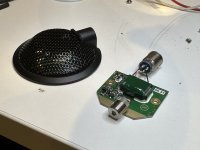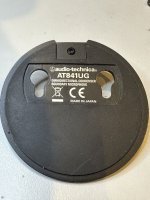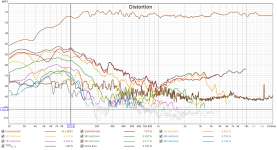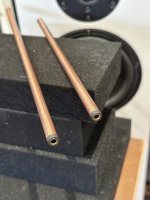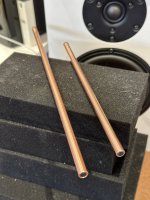I am trying to set up a mic that might work as speaker measurement tool, and I remembered I had two of these AT841UG omnidirectional mics running on phantom power which can be supplied from Scarlet 2i2 I also have. The capsule looks like it means business. From test measurements SPL looks fairly flat but distortion figures are a bit concerning.
Attachments
Dear >zdr<
Please just have a look here:
https://www.diyaudio.com/community/...on-measurement-challenge.407527/#post-7560023
If you manage to measure this way your measurement setup and mic is ok.
If not, please post your try, we will make it work ;-)
Best regards, Bernd
Please just have a look here:
https://www.diyaudio.com/community/...on-measurement-challenge.407527/#post-7560023
If you manage to measure this way your measurement setup and mic is ok.
If not, please post your try, we will make it work ;-)
Best regards, Bernd
Thanks for the reply. In the meantime I found two capsules which gave a lot less distortion right off the bat, so went ahead and made two mics out of them. The AT mic in OP is omnidirectional conference room mic, so not sure it's worth the effort. My main concern now is how to calibrate the mics without having any other calibrated equipment I could compare them to.
Attachments
There is no need for calibration.My main concern now is how to calibrate the mics without having any other calibrated equipment I could compare them to.
The demand for microphone calibration is the approach of commercial participants to squeeze more money from the DIY community. If one of their products is inferior, the DIYer can find out without calibration. Start with your distortion measurements. Join the challenge. Do not get deterred.
The approach i show in LRDDMC is designed to deliver a meaningful result with any microphone. I repeat: any microfone. It just happens you already own the AKG. The beautiful sticks you build are a really competent approach. Join the Challenge, we will find out about your microphones.From test measurements SPL looks fairly flat but distortion figures are a bit concerning.
Btw. your measurement looks very promising ;-)
Of course you need calibration in case you want to measure a loudspeaker's frequency characteristic (SPL) . A relativley easy way is to have a known system measured by some ref mic and compare the measured SPL curve ( file) to your mic. The difference between one and the other measurement (an .frd or .txt file) will be your mic calibration file as applicable in e.g. ARTA. That diff file, your calibration file, could be generated by VituixCad or REW.
While current distortion correlates to some degree with acoustic distortion its important to measure frequency response acoustically. For that I would start with the manufacturers specs for response. Expect a 3 to 5 dB variation worst case if its a good mike. Measuring acoustic distortion is difficult sine ambient noise can be detected as distortion. Coherent averaging can help remove those errors. Measuring the voltage distortion with a current source (or series resistor) may make it easiier to see some of the distortion mechanisms but is not practical unless to build the amp to work with the driver. And the nonlinearity of the magnet and suspection is still there, it just reacts differently with a compliant (current mode) drive.
- Home
- Design & Build
- Equipment & Tools
- Audio Technica AT841UG as measurement mic
